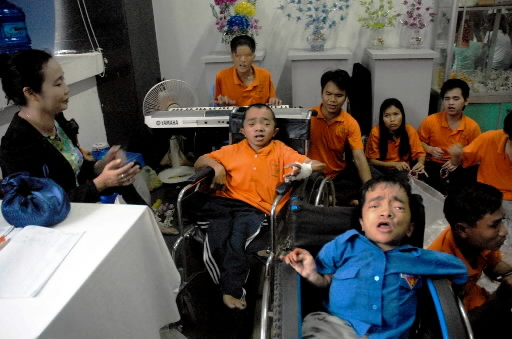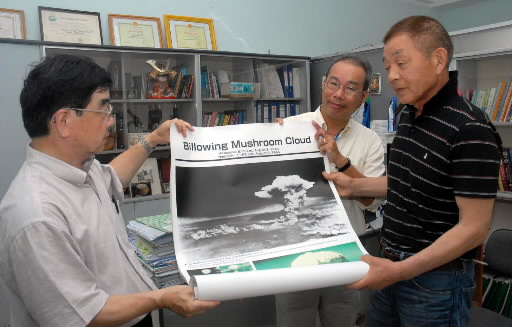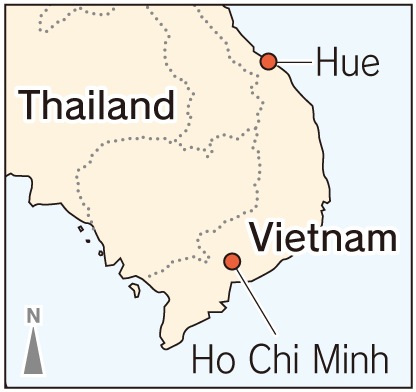Vietnam: 50 years after the use of defoliants, Part 1: Walking the affected areas, Article 7
Jul. 13, 2012
Article 7: Joining hands with Hiroshima
Hopes for exchange of information and interaction
by Takamasa Kyoren, Staff Writer
Determination to convey reality of war
In early May, Huynh Ngoc Van, 49, director of the War Remnants Museum, sent a collection of images documenting the effects of defoliants used during the Vietnam War to Hiroshima Peace Memorial Museum. “If the situation here is conveyed to Hiroshima, we will be able to get a lot of support from around the world,” said Ms. Huynh as she stood in one of the museum’s exhibition rooms.
The museum, which is located in downtown Ho Chi Minh City, displays about 1,500 items including tanks and guns used in the war, explanatory displays and photographs of children who were injured in bombing strikes or who suffer the effects of defoliants. About 10 residents of a nearby facility that provides support for the victims of defoliants gave a musical performance in the museum’s lobby. A blind youth provided piano accompaniment for a young man suffering from a disease that has caused his muscles to atrophy.
In 2002 an exhibition on the atomic bombings was held at the museum. It was organized by a Hiroshima-based organization for atomic bomb survivors and others. “I sensed a commonality between the atomic bombings and the use of defoliants, both of which have resulted in years of suffering,” said Ms. Huynh, who was the museum’s assistant director at the time of the exhibition. In 2005 Ms. Huynh was invited by a citizen’s group to give a lecture in Hiroshima. But in recent years there have been fewer visits back and forth, she said.
Visit under consideration
In Vietnam as well, memories of the war are fading. Ms. Huynh asks former soldiers to talk about their experiences at elementary and junior high schools and at the museum. Last year the museum had 660,000 visitors from at home and abroad. “Hiroshima’s desire for peace has been conveyed to the world,” Ms. Huynh said. “While interacting with people from Hiroshima, I would like to consider how Vietnam can make its plea heard.”
In August, when Hiroshima holds its peace memorial ceremony, Vietnam sets aside the 10th to recognize the victims of defoliants. The Vietnam Association for Victims of Agent Orange/Dioxin (VAVA) is considering sending a delegation to the August 6 peace memorial ceremony for the first time this year in an effort to align itself with the spirit of the people of Hiroshima. On August 10 VAVA will mark the 10th anniversary of its founding with a ceremony in Ho Chi Minh City. The organization’s local branch has invited four members of the Hiroshima-Vietnam Association, based in the city of Hiroshima, to attend.
In early May, members of the Hiroshima Vietnam Peace and Friendship Association, which is based in Higashi Hiroshima, went to Hue as part of their effort to support defoliant victims. They presented a poster on the effects of the atomic bombing to Nguyen Viet Nhan, 53, chief of the Department of Medical Genetics at Hue College of Medicine and Pharmacy. “We have a lot to learn from Hiroshima,” said Dr. Nguyen as he looked at the poster in a hospital laboratory.
In the late 1990s Dr. Nguyen investigated the effects of the defoliants that were sprayed on central Vietnam from 1961 to 1971. In areas where defoliants were sprayed, the rate of babies born with abnormalities was from two to 20 times more than in areas where defoliants were not sprayed. In 1999 Dr. Nguyen set up a non-governmental organization to provide support to second-generation victims of defoliants, and he continues to offer advice on their rehabilitation and health maintenance. But, he said regretfully, “A nationwide survey has yet to be done.”
“Turn for the better”
While covering the story of defoliants in Vietnam, other reporters and local people involved with the issue asked me about those who are still suffering from the effects of radiation, what sort of government support is provided to atomic bomb survivors and other questions about the A-bombing of Hiroshima. Many people conveyed a strong desire for solidarity.
“As a scientist, it is not my intention to simply liken the effects of defoliants to those of the atomic bombing,” Dr. Nguyen continued. “But since the war Hiroshima has conducted systematic research into the effects of the atomic bombing and provided extensive aid for the survivors. If we could exchange more information, things would take a turn for the better in Vietnam.” Progress continues amid the unending ravages of war.
(This is the final article in Part 1 of this series.)
(Originally published on June 26, 2012)










